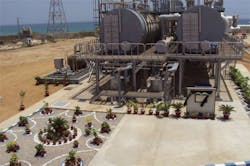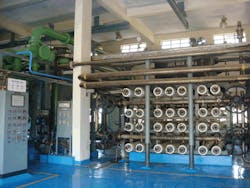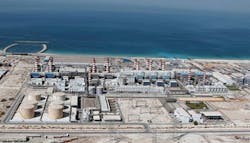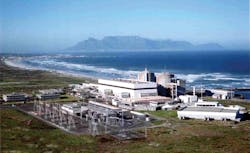Technical maturity and versatility fuel interest
By William Steel
As the pressures of water security become more acute around the world, the significance of desalination as means of ensuring potable water supplies has never been greater. But with the expected growth of global desalination capacity comes a problem: processes remain heavily reliant on fossil fuels. According to the Global Clean Water Desalination Alliance, global installed desalination plants emit some 76 million tons of CO2 per year, an amount expected to reach around 218 million tons by 2040.
Clear alternatives do exist, namely ambitions and projects for desalination via renewables. Still, with emissions and water security high on the global agenda, another solution presents itself in the form of nuclear-powered desalination.
It’s not a new idea — it’s well documented as a feasible, reliable and efficient solution for process integration with desalination technologies of several flavors. A key strength of nuclear power plants (NPPs), aside from technical maturity, is their capacity to supply either thermal or electrical energy, or both, to respective desalination processes, at varying scales.
In Abu Dhabi, UAE, four nuclear power units of 1400 MW are being constructed at Al Barakah, which could advance the Abu Dhabi power and desalination program.
“We can think of nuclear-powered desalination in terms of two main applications. One is to serve make-up water resources for the plant; the other is to produce potable water. Both applications have already been demonstrated,” said Ibrahim Khamis from the International Atomic Energy Agency (IAEA) department of nuclear energy.
Precedent notwithstanding, Khamis explained that “nuclear-powered desalination of potable water isn’t currently widespread or deployed at large scale.”
A notable exception was the now-offline Aktau plant in Kazakhstan. A flagship nuclear desalination plant pioneered by the Russian nuclear industry, Aktau was commissioned in 1967 and operated for 40 years, supplying Aktau’s population (over 150,000 people) and industry with fresh water.
A few examples of nuclear-powered desalination in operation do exist. “Only recently we’ve moved from a few thousand cubic meters daily production to tens of thousands cubic meters daily production being built — it’s scaled up but not greatly,” said Claus Mertes with leading desalination consultancy DME on the state of global nuclear desalination.
He continued: “India, Pakistan, Iran and China already have nuclear-powered desalination capacity, although not at the scale that nuclear power could easily achieve — say 1 million cubic meters per day. We currently see plants with 10,000-15,000 cubic meters daily production using multi-effect distillation with thermal vapor compression (MED-TVC), reverse osmosis (RO) or multi-effect distillation (MED) processes. These plants are in operation today, and several have plans to increase production capacities.”
An Effective Pairing
Support for the growth of nuclear-powered desalination comes from the International Desalination Association (IDA). “Nuclear energy is clean and is able to provide the high amounts of energy that desalination requires,” said Leon Awerbuch, IDA director. “Aside from potential environmental or climate benefits, nuclear-powered desalination has advantages over conventional (fossil-fuel based) desalination in terms of costs — it has great potential to be a very cheap source of desalination capacity.”
Speaking about recent work that IDA has undertaken in collaboration with IAEA and other stakeholders on the matter, Awerbuch said there is “consensus among experts on the optimum technology solutions for nuclear desalination that it’s the use of straight MED technology hybridized with RO.”
In Pakistan, a 1,600 m3/day MED desalination plant is coupled to KANUPP NPP, and slated for expansion via addition of a second 1,600 m3/day MED system.
According to Awerbuch, in order to minimize energy consumption and reduce NPP power losses, it’s recommended to use the lowest extraction steam pressure available using straight MED, rather than MED-TVC. “The NPP’s low-pressure extraction steam is exchanged in a separate condenser to a closed cooling water circuit,” he explained. The heat absorbed by the water is transferred by pipeline to the MED flashing chamber to provide steam for the first effect of MED. The cooled flashed water is pumped by return water pipeline to condensers.
A significant benefit of such a design is that heat can be transferred long distances via water pipelines, enabling NPP power and “water islands” to be separated, and thereby for desalination to comply with nuclear code requirements.
Analysis of existing nuclear-powered desalination plants reveals that varied configurations of nuclear-desalination technology coupling perform favorably. In an IAEA life-cycle assessment study, Khamis reported that nuclear desalination can be 50-70 percent cheaper than gas- and oil-fired processes, with estimated water costs under $1/m3 for nuclear RO and nuclear MED, depending on conditions.
“Nuclear cogeneration of electricity and heat for desalination brings benefits because some required facilities such as the intakes and outfalls can be shared, as in the case of hybrid plants. It also enables design strategies for better thermodynamic efficiency besides economic optimization,” IAEA’s Khamis explained, highlighting instances of waste heat from nuclear power reactors being reused for nuclear desalination.
“For example, a Japanese design of very high-temperature, gas-cooled nuclear reactors produces waste heat at about 150˚C, which is suitable for multi-stage flash distillation (MSF) desalination. A South African gas-cooled reactor design produces waste heat at about 65˚C, which is very suitable to low temperature MED nuclear desalination. It’s a major opportunity for desalination (and other uses such as district heating).”
Beyond effectiveness of NPPs for powering desalination, another synergy between the two stems from the fact that desalination (typically via RO) is invariably required toward the beginning of nuclear plant construction for cold testing, cleaning, and other operations. Retaining even modest onsite desalination capacities for operational use after plant construction brings a host of advantages to plant operators. Considering the complementarity between nuclear power and desalination, extending desalination capacity further, so as to enable freshwater supply to local populations, would appear a logical option for regions in need of both power and fresh water. Indeed, it’s an increasingly favorable proposition.
In India, two desalination plants operate at Kalpakkam NPP, producing 4,500 m3/day (MSF thermal) and 1,800 m3/day (SWRO); a 10,240 m3/day (MED-TVC) plant operates at Kudankulam; and several new projects are planned with combined desalination capacity of around 1,600 m3/day.
Rising Interest
According to experts, considerable interest in deploying nuclear desalination technology is evident in the Middle East and the North Africa region — notably in Saudi Arabia, UAE, Egypt, Tunisia, Morocco, and Algeria — but also in South American states and Japan.
Nations with existing nuclear desalination capacity — China, Pakistan and India — also hold plans for extending capacities, some of which were highlighted earlier. Here, the forecast for expansion is relatively straightforward to anticipate — something that isn’t the case in nations without nuclear desalination capacity, and even less so in ones without nuclear power infrastructure.
“We’re aware of projects underway, several that are not in the public domain. In general there’s a handful of countries pursuing development of desalination process integration with nuclear power,” said Mertes.
A recurring feature amongst these projects is Rosatom — the Russia state-led nuclear energy agency. “Rosatom are certainly very aggressive in marketing their nuclear technologies, and they’re also very excited, it appears, about coupling with desalination,” said Awerbuch.
In Abu Dhabi, UAE, four nuclear power units of 1400 MW are being constructed at Al Barakah; Awerbuch expects the developments to have significant consequence in advancing the Abu Dhabi power and desalination program.
Jebel Ali M-Station, operated by Dubai Electricity and Water Authority (DEWA), is the UAE’s largest electricity generation and desalination plant.
A project unfolding in India involves exploring novel thorium-fueled NPPs. “These projects are not well publicized but involve designing novel advanced headwater reactors, operating mainly from thorium, coupled with desalination. They are planning three MED units with combined capacity of almost 2,400 m3/day and another unit for low temperature MED, producing 600 m3/day,” said Khamis.
To Mertes, the bottom line is clear: “To integrate a desalination process into a nuclear power plant is no issue at all. The question of nuclear desalination isn’t a technical one and it’s not a matter of money either — it’s about regulators.”
The main barrier to nuclear-powered desalination, Mertes noted, is gaining license from the national regulator permitting a nuclear plant to produce water for public domain water usage. This kind of licensing, he explained, is a long-winded, nationally coordinated affair, and it’s this that Mertes describes as the largest “showstopper” in Saudi Arabia and other nations seeking nuclear desalination.
Mertes expanded on licensing: “What we tend to see is operators secure licenses for desalinating water for internal water usage within the NPP (for make-up water, etc.) and from there gain permission for that water to be supplied to workers on-site. The next step is to extend licenses to cover delivery of water to external, public sources.”
Just such a process is underway in South Africa amidst the ongoing strains of chronic water shortage on the Western Cape. Public utility Eskom recently completed installation of a small, mobile groundwater desalination plant at its Koeberg NPP. The development reduces the plant’s demand on the local water supply, but Eskom is now collaborating with Cape Town authorities to establish a larger seawater RO desalination plant to produce up to 5,000 m3/day for public supply as a demonstration plant for even larger projects.
A similar process was being planned at Diablo Canyon nuclear plant in California but was sidelined when nuclear power itself came under scrutiny, leading to the decision to shutter the plant altogether — dousing the desalination plans in the process.
While both nuclear power and desalination technologies are highly mature, their coupling still conveys perceived radioactivity risk. Negative public perceptions of anything nuclear do weigh into the issue and present an unfortunate hindrance.
South African public utility Eskom recently completed installation of a small, mobile groundwater desalination plant at its Koeberg NPP.
Commenting on IAEA’s recent study regarding experience with nuclear desalination product water quality, Khamis noted that all operated/operating nuclear desalination facilities (including Kazakhstan’s AKTAU and MAEC large nuclear desalination plant) reported no radioactive contamination in their desalination plant streams, and the quality of water is in full compliance with World Health Organization (WHO) standards for natural drinking water. “[This is] thanks to the various engineering concepts implemented in nuclear desalination plants that ensure isolation and full monitoring of product water,” he said.
The fundamental obstacle for nations seeking nuclear desalination capacity, therefore, stems from a requirement of licensing authorities, as Mertes explained: “National regulators are asking for case studies of process-integrated nuclear-powered desalination to validate against. They are asking operators to show multiple case studies where this has been accomplished, safely, in the past and in their country.”
It’s a catch-22 situation that makes for “a case of chicken and egg,” according to Mertes.
“Where do we find the first sufficient case studies in order to satisfy regulators when you cannot copy from another country?” he said, noting that “regulators in India, Pakistan and China are rather more relaxed in this context.”
Khamis said: “The obligation in some cases to have a reference plant, which is not available yet, is a major barrier to development of nuclear desalination. Diablo Canyon could have been a global reference case.”
For their part, nuclear power vendors appear eager to facilitate demonstration plants. It’s perhaps of little surprise: a review of major nuclear power suppliers reveals that desalination is invariably presented as a key application of their various offerings.
“Both existing and next-generation nuclear reactor providers are all considering nuclear desalination as part of their increasingly important non-electric operations, and actively pursuing integration with desalination processes, including how to operate reactors in hybrid mode with part of the electricity for RO and heat for thermal MED desalination,” Khamis said.
A hope from desalination stakeholders is that national regulations for nuclear-powered desalination (e.g., design and operating standards) be expedited and communicated to relevant supply chain players so as to help overcome the present lack of reference plants meeting a threshold of quality control and validity.
Horizons
Another aspect of nuclear desalination technology that warrants attention involves a new breed of nuclear technology. Small modular reactor (SMR) nuclear technology is still in development but is widely pitched for big things.
SMR front-runners include U.S.-based NuScale and the South Korean System-integrated Modular Advanced Reactor (SMART), the Argentinean CAREM, and the Chinese Deep-pool Low temperature Heating Reactor (DHR). All promise SMR benefits including lower capital costs, safer and more resilient designs, lower operating costs and shortened plant build times.
“NuScale’s SMR design is under review and is on schedule to be certified by one of the world’s leading regulators, the U.S. Nuclear Regulatory Commission (NRC). The NRC has already completed the first and most intensive phase of its review process, more rigorous than the five remaining phases combined,” said NuScale Chief Commercial Officer Tom Mundy.
Mundy said that NuScale’s 50 MWe size and multi-module plant design “permits a high degree of flexibility for deployment in a wide range of conventional and unique electrical and thermal applications, making it a particularly attractive energy source for desalination processes at various scales.”
Because a NuScale Power Module produces 160 MWt of steam, plants can be arranged such that some modules are dedicated to electricity production while others provide steam and heat to support industrial processes, including desalination. “This feature makes the NuScale design ideal for hybrid energy applications in which multiple energy sources are integrated with multiple energy-consuming processes to form a highly optimized and efficient system,” said Mundy.
While NuScale’s first 12-module plant is slated for operation by the mid-2020s in the United States, Mundy reports the company is “seeing considerable interest in NuScale’s SMR technology in regions of the world where fossil fuel is the source of heat and electricity for desalination such as in the Middle East.”
Khamis agreed SMRs hold promise but cautioned that deployment has still to materialize. “Should SMRs deployment and operation prove to be successful, then this would absolutely open doors for nuclear desalination, especially for remote areas. Studies and first operations will determine if it’s economically and technically feasible.”
Advent of SMRs aside, both nuclear and desalination stakeholders seem to share patient optimism for the opportunities afforded through coupling their respective technologies. “We will see strong developments mostly in China, then Pakistan, then India,” Mertes said. “Others are watching developments, and we will see regulators in water-stressed countries with nuclear capacity relax a little.”
South Africa is a good candidate for such development in Mertes’s view, alongside Brazil, where massive water demand, desalination experience, and national nuclear power capacity are in nuclear desalination’s favor. “From a regulatory and technical point of view, too, Brazil is able to follow through,” Mertes added.
In closing, Awerbuch drew attention to the Middle East: “Nuclear will be important to desalination in the medium to long term and I expect that the combination of Russia’s push and MENA interests will see most development in that region. Saudi Arabia has a really good chance to move first; much of its desalination capacity is over twenty years old and they have clear targets for establishing nuclear power capacity in the coming decades.” IWW
About the Author: William Steel is a freelance reporter covering renewable energy, water and cleantech industries.






